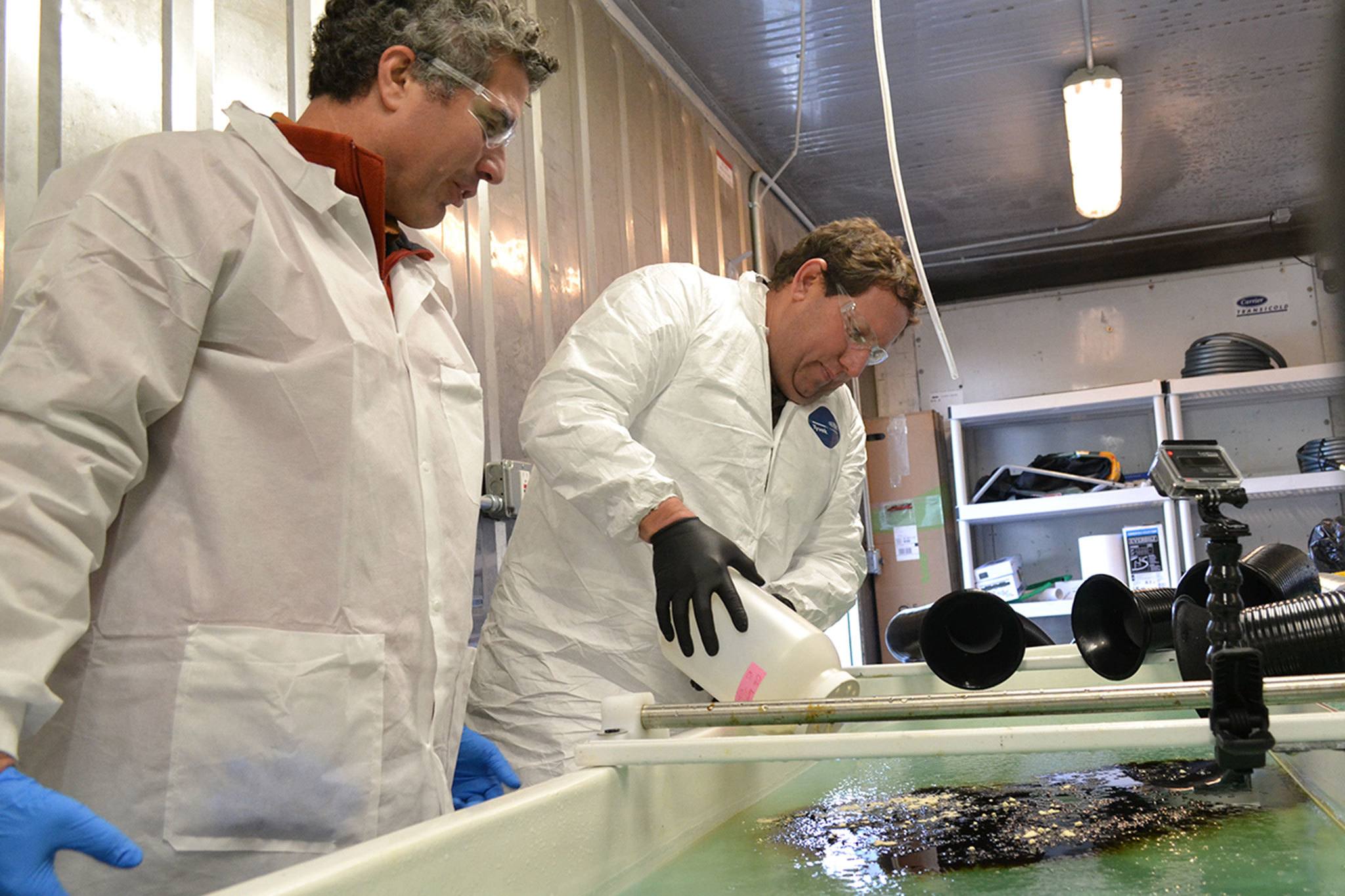Stopping an oil spill could be as simple as the shake of a bottle and lighting a match thanks to some local scientists.
A team with the Pacific Northwest National Laboratory between Sequim and Richland, sponsored by the Department of the Interior’s Bureau of Safety and Environmental Enforcement, continues to fine-tune a product that pulls and holds an oil spill together so it can burn specifically in low temperature areas like the Arctic.
George Bonheyo, senior research scientist for the laboratory and a research professor of biotechnology for Washington State University – Pullman, leads the team and said the product could be a year away from going to market and made available to agencies like the U.S. Coast Guard.
“There’s eventually going to be an accident whether (the U.S.) drills or not,” Bonheyo said.
Robert Jeters, project manager for the product, called an aggregator, concurs.
“There’s a vast amount of oil in the Arctic and more countries are drilling there as ice sheets shrink,” Jeters said. “This project will help agencies mitigate spills in the future.”
The aggregator is a wood flour that’s fine dust from wood processing but chemists modify it by attaching oil-attracting chemicals to the surface, Bonheyo said.
It’s all-natural, renewable and non-toxic, he says, and repels water, prevents ice formation and works in high winds.
One methodology for burning oil in water involves spraying chemicals to create an oil slick to make it easier to burn but the oil needs to be at least 3 millimeters thick and in low wind and the chemical, which contains toxins, diffuses quicker, Bonheyo said.
In icy conditions, he said skimmers and oil booms don’t work as well either.
The laboratory’s wood aggregator acts like a candle wick continuing to draw the oil up to the surface with scientists’ objective to burn and remove at least 90 percent of the oil, Bonheyo said.
Response crews can pick up any residual oil and/or it can break down over time.
“(The aggregator) promotes microbial growth to help break it down,” Bonheyo said. “It can remain on the water for up to four months and sunlight, oxygen and microorganisms will help break down the oil.”
Jeters said they continue to seek the best ratios of aggregator to oil.
In studies, scientists use pre-weighed pads to collect residue and they weigh each pad to see how much residue was left.
The water is pumped through activated charcoal to remove any residual hydrocarbons as part of a clean-up process so the water is pure seawater, Bonheyo said.
“It’s part of the reason Sequim is unique is because we make sure experiments don’t impact the environment,” he said.
Big tests
In October, scientists performed large-scale tests of the aggregator at the Joint Marine Test Facility in Mobile, Ala. It and Sequim are one of four labs in the nation where they can do oil burn experiments of this level that they know of, Bonheyo said.
In Mobile, they burned about 1.5 gallons of crude oil with aggregator attached to measure surface area.
Jeters said the tests gave them good ratios for the product to oil ratio after they measured the burn efficiencies.
But they’ll continue to test those ratios along with how efficient the different burns are depending on the environment, the best strategies for applying the material, and more.
Back in Sequim, they continue to study the oil in icy conditions whereas in Alabama it’s too warm to replicate Arctic conditions, Bonheyo said.
They use a 320-square-foot freezer laboratory that can go as low as -15 degrees Celsius.
In the coming months, Jeters said scientists will do more analysis of the aggregator’s efficiency and laboratory staff will work through the intellectual property rights to the product.
“If patented, it will be licensed out to a company that will use it in the real world,” Bonheyo said.
“Our role as scientists is to develop the technology and transfer to others to turn into a commercial product.”
Multiple agencies such as the Environmental Protection Agency will evaluate the product’s environmental and human safety impact and give recommendations before it is approved, too.
Ideally, the aggregator would go to shipping containers with oil response kits in critical harbors in the U.S., Bonheyo said.
One of the focuses of the laboratory has focused on studying oil spills and their effects since the 1960s but Bonheyo said they’ve shifted over the years to focus more on clean-up methodologies.
He said the push for the aggregator was to find a technology that burns oil as effectively as the Deepwater Horizon oil spill event in 2010 in the Gulf of Mexico that saw 210 million gallons discharged.
So far, Bonheyo said the aggregator project has received a lot of attention.
“It’s exciting to bring things into real world application,” he said. “It makes you feel good.”
He also feels a sense of pride for doing a large portion of the research in Sequim.
The Pacific Northwest National Laboratory is owned by the U.S. Department of Energy and operated by Battelle.
The laboratory’s ability to burn for experiments has been approved by by the Olympic Region Clean Air Agency, Bonheyo said.
For more information on this research and others, visit www.pnnl.gov.



